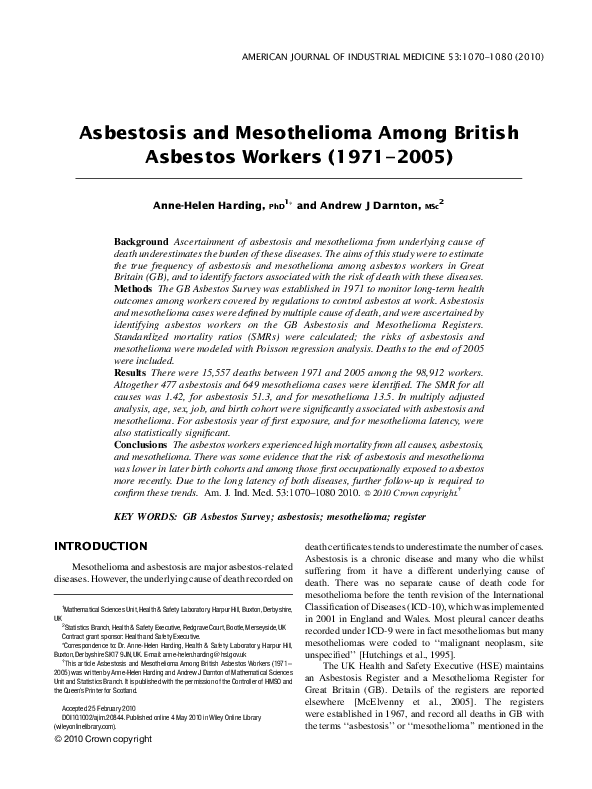Asbestosis and mesothelioma among British asbestos workers (1971-2005)

Harding, Anne-Helen ; Darnton, Andrew J.
American Journal of Industrial Medicine
2010
53
11
1070-1080
asbestos ; asbestosis ; latency ; long term exposure ; mesothelioma ; mortality ; registers of occupational diseases ; survey
Asbestos
English
Bibliogr.
"Background: Ascertainment of asbestosis and mesothelioma from underlying cause of death underestimates the burden of these diseases. The aims of this study were to estimate the true frequency of asbestosis and mesothelioma among asbestos workers in Great Britain (GB), and to identify factors associated with the risk of death with these diseases.
Methods: The GB Asbestos Survey was established in 1971 to monitor long-term health outcomes among workers covered by regulations to control asbestos at work. Asbestosis and mesothelioma cases were defined by multiple cause of death, and were ascertained by identifying asbestos workers on the GB Asbestosis and Mesothelioma Registers. Standardized mortality ratios (SMRs) were calculated; the risks of asbestosis and mesothelioma were modeled with Poisson regression analysis. Deaths to the end of 2005 were included.
Results: There were 15,557 deaths between 1971 and 2005 among the 98,912 workers. Altogether 477 asbestosis and 649 mesothelioma cases were identified. The SMR for all causes was 1.42, for asbestosis 51.3, and for mesothelioma 13.5. In multiply adjusted analysis, age, sex, job, and birth cohort were significantly associated with asbestosis and mesothelioma. For asbestosis year of first exposure, and for mesothelioma latency, were also statistically significant.
Conclusions: The asbestos workers experienced high mortality from all causes, asbestosis, and mesothelioma. There was some evidence that the risk of asbestosis and mesothelioma was lower in later birth cohorts and among those first occupationally exposed to asbestos more recently. Due to the long latency of both diseases, further follow-up is required to confirm these trends."
Digital
The ETUI is co-funded by the European Union. Views and opinions expressed are however those of the author(s) only and do not necessarily reflect those of the European Union or the ETUI.